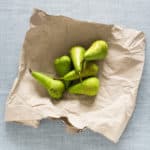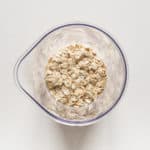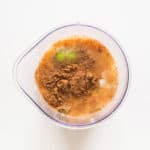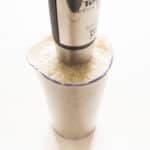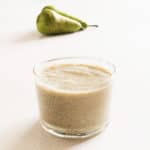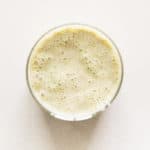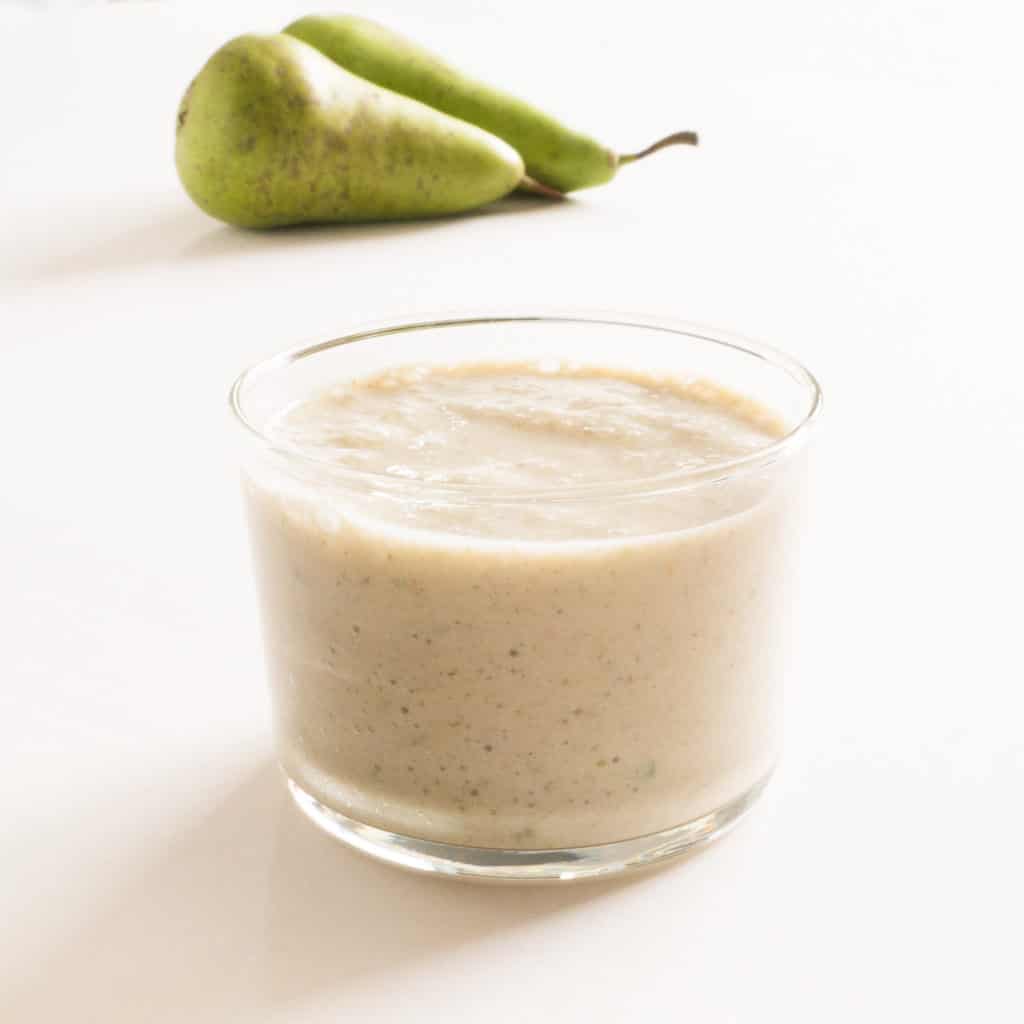
Autumn is well and truly here and what better way to start the day than with a super seasonal, Gluten-Free, Vegan, Pear and Cinnamon Breakfast Smoothie. Pear and Cinnamon Smoothie is the ultimate autumn smoothie. Using seasonal fruit means the smoothie is packed full of flavour and nutrients. A perfect way to start your weekend or your working day. Pears lend themselves perfectly to a smoothie, gluten-free oats add texture and substance… The cinnamon and pear is warming and satisfying and gives you a big morning hug.
Gluten-Free, Vegan, Pear and Cinnamon Breakfast Smoothie is quick and easy to make. You will need a blender (immersion, jug or food processor) to blend the smoothie. The smoothie works better if you mix the ingredients and leave them in the fridge overnight before blending.
You can find the full Gluten-Free, Vegan, Pear and Cinnamon Breakfast Smoothie recipe here.
Depending on when you make this you can use other seasonal fruit and sub the cinnamon for other spices. You can also use frozen fruit (thawed).
This Gluten-Free, Vegan, Pear and Cinnamon Breakfast Smoothie is not only the prefect gluten-free, vegan start to the day but also a great pudding too. Perfect to follow Fennel, Radish and Orange Salad or Chard, Courgette and Pea Tart.
Preparation – Gluten-Free, Vegan, Pear and Cinnamon Breakfast Smoothie
Difficulty easy
Serves
Preparation time XX minutes
Cooking time XX hours
You can find the full Pear and Cinnamon Smoothie recipe here.
Allergens – Gluten-Free, Vegan, Pear and Cinnamon Breakfast Smoothie
Pear and Cinnamon Smoothie is gluten-free and vegan as well as…
Celery free
Coconut free
Garlic free
Lupin free
Mustard free
Nightshade free
Onion free
Peanut free
Sesame free
Soya free
Tree nut free
What’s the Deal with Pears?
Super versatile and in-season pears are delicious and a firm favourite. As well as in smoothies I love them slightly under-ripe as a snack and in salads with bitter cos lettuce and a tangy dressing. The classic poached pears is a stunningly simple, yet striking way, to present pears.
The pear tree
The pear can be one of several tree and shrub species of genus pyrus in the family rosaceae. Pear is also the name of the pomaceous fruit of the trees. Several species of pear are valued for their edible fruit and juices, while others are cultivated as ornamental trees.
Origins and spread of pears
Native to coastal and mildly temperate regions of western Europe and north Africa east and across Asia pear trees are medium-sized, reaching 10–17 metres in height, often with a tall, narrow crown. There are a few shrub species. Most pear trees are deciduous however, one or two species in southeast Asia are evergreen. Most trees are cold-hardy, withstanding temperatures between −25 °C and −40 °C in winter (except for the evergreen species, which only tolerate temperatures down to about −15 °C).
In most wild species of pear the fruit is one to four centimetres diameter however, in some cultivated forms the fruit is up to 18 centimetres long and 8 centimetres wide. The shape varies from round to the classic ‘pear-shape’ of the European pear. It is sometimes difficult to distinguish between pear and apple fruit: some pears look like some apples, e.g. the nashi pear. One major distinguishing factor is that the flesh of pear fruit contains stone cells (also called “grit”).
Evidence of pear cultivation has been found in prehistoric pile dwellings around Lake Zurich. The pear was also cultivated by the Romans, who ate the fruits raw or cooked, just like apples. Pliny’s Natural History recommended stewing them with honey and noted three dozen varieties. The Roman cookbook De re coquinaria has a recipe for a spiced, stewed-pear patina, or soufflé. Pears have been cultivated in China for approximately 3000 years.
What do you do with pears?
Super versatile, pears and can be eaten fresh, canned, as juice, and dried. The juice can also be used in jellies and jams, usually in combination with other fruits, including berries. Fermented pear juice is called perry or pear cider and is made in a similar way to how cider is made from apples.
Pears are wonderful in sweet and savoury food and are great in salads, providing crunch and sweetness.
To judge ripeness of a pear gently press the neck or stem end of the pear. Pears ripen from the inside out. If the pear yields to gentle pressure, then the pear is ripe, sweet, and juicy. If it is firm, leave the pear at room temperature.
Nutritional value of pears
Raw pear is 84% water, 15% carbohydrates and contains negligible protein and fat. A 100 gram serving of raw pear provides carbohydrates and 57 kilo-calories. Pears are a good source of dietary fibre, but otherwise provide no essential nutrients in significant amounts.
What’s the Deal with Cinnamon?
There are two types of cinnamon available in shops; ground spice and bark. Its scent and flavour are powerful and unmistakable. Cinnamon reminds me of winter and especially of Christmas. Cinnamon flavoured drinks and desserts are a firm favourite.
What is cinnamon?
Cinnamon is a spice. Cinnamon comes from the inner bark of several tree species from the genus Cinnamomum. Cinnamon can be used in both sweet and savoury foods. Cinnamon is the name for several species of trees and the commercial spice products that some of them produce. All are members of the genus Cinnamomum in the family Lauraceae. Only a few Cinnamomum species are grown commercially for spice.
The cinnamon tree is an evergreen tree characterised by oval-shaped leaves, thick bark, and a berry fruit. When harvesting the spice, the bark and leaves are the primary parts of the plant used. Cinnamon is cultivated by growing the tree for two years, then coppicing it. The following year, about a dozen new shoots form from the roots, replacing those that were cut.
The stems must be processed immediately after harvesting while the inner bark is still wet. The cut stems are processed by scraping off the outer bark, then beating the branch evenly with a hammer to loosen the inner bark, which is then pried off in long rolls. Only 0.5 millimetres of the inner bark is used; the outer, woody portion is discarded, leaving metre-long cinnamon strips that curl into rolls (“quills”) on drying. The processed bark dries completely in 4-6 hours, provided it is in a well-ventilated and relatively warm environment. Once dry, the bark is cut into 5-10 centimetre lengths for sale.
Cinnamon is grown commercially in Indonesia, Sri Lanka, China, Vietnam, Brazil and various other countries. It is not difficult to grow but requires a relatively dry, free draining soil.
Origins and spread of cinnamon
It is not clear where the cinnamon tree originated. However, it is commonly thought to be Sri Lanka (Ceylon) but this is not clear. Sri Lanka is a very large producer of cinnamon but the origins of cinnamon are not clear.
Cinnamon was known in the Greek, Roman and Egyptian cultures. The first Greek reference to kasia is found in a poem by Sappho in the seventh century BC. According to Herodotus, both cinnamon and cassia grew in Arabia, together with incense, myrrh, and labdanum, and were guarded by winged serpents. According to Pliny, a Roman pound (327 grams) of cassia, cinnamon, or serichatum cost up to 300 denarii, the wage of ten months labour. Cinnamon was too expensive to be commonly used on funeral pyres in Rome, but the Emperor Nero is said to have burned a year’s worth of the city’s supply at the funeral for his wife Poppaea Sabina in AD 65. Egyptian recipes for kyphi, an aromatic used for burning, included cinnamon and cassia from Hellenistic times onward. The gifts of Hellenistic rulers to temples sometimes included cassia and cinnamon. In ancient Egypt, cinnamon was used to embalm mummies.
During the 1500s, Ferdinand Magellan was searching for spices on behalf of Spain, and in the Philippines found Cinnamomum mindanaense which was closely related to C. zeylanicum, the cinnamon found in Sri Lanka. This cinnamon eventually competed with Sri Lankan cinnamon, which was controlled by the Portuguese.
In 1638, Dutch traders established a trading post in Sri Lanka, took control of the manufactories by 1640, and expelled the remaining Portuguese by 1658. “The shores of the island are full of it,” a Dutch captain reported, “and it is the best in all the Orient. When one is downwind of the island, one can still smell cinnamon eight leagues out to sea.” The Dutch East India Company continued to overhaul the methods of harvesting in the wild and eventually began to cultivate its own trees.
In 1767, Lord Brown of the British East India Company established Anjarakkandy Cinnamon Estate near Anjarakkandy in the Cannanore district of Kerala; it became Asia’s largest cinnamon estate. The British took control of Ceylon from the Dutch in 1796.
What do you do with cinnamon?
The flavour of cinnamon is due to an aromatic essential oil that makes up 0.5-1% of its composition. This essential oil is prepared by roughly pounding the bark, macerating it in sea water, and then quickly distilling the whole. It is of a golden-yellow colour, with the characteristic odour of cinnamon and a very hot aromatic taste. The pungent taste and scent come from cinnamaldehyde (about 90% of the essential oil from the bark) and, by reaction with oxygen as it ages, it darkens in colour and forms resinous compounds.[30]
Cinnamon bark is used as a spice. It can be used ground or whole (if used whole it is removed before serving). It is used in the preparation of chocolate, especially in Mexico, cinnamon is often used in savoury dishes e.g. stews. Cinnamon and sugar are often used to flavour cereals, bread-based dishes, such as toast, and fruits, especially apples. Cinnamon can also be used in pickling and Christmas drinks.
Nutritional value of cinnamon
10 grams (~2 teaspoons) of ground cinnamon contains 24.7 kilo-calories, 0.12 grams fat, 8.06 grams carbohydrate (5.31 grams fibre, 0.2 grams sugars) and 0.4 grams protein.
